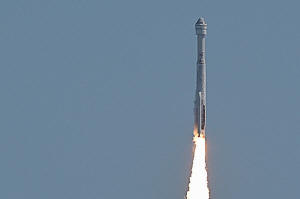NASA astronauts voice confidence that Boeing Starliner will bring them
home
 Send a link to a friend
Send a link to a friend
 [July 11, 2024]
By Joey Roulette [July 11, 2024]
By Joey Roulette
WASHINGTON (Reuters) -The first two astronauts to fly Boeing's Starliner
capsule said from the International Space Station on Wednesday they were
confident in the spacecraft's ability to return them home whenever the
company and NASA solve thruster issues that have kept them in space far
longer than expected.
"I have a real good feeling in my heart that this spacecraft will bring
us home, no problem," NASA astronaut Sunita "Suni" Williams said during
the test crew's first news conference since docking to the ISS more than
a month ago.
Williams and Barry "Butch" Wilmore, both veteran NASA astronauts and
former U.S. Navy test pilots, were launched aboard Starliner from
Florida on June 5 and docked the next day at the ISS, where they were
initially scheduled to spend roughly eight days.
Several issues with Starliner's propulsion system have extended their
mission indefinitely. Five of Starliner's 28 maneuvering thrusters
failed during its trek to the station, a propellant valve did not
properly close and there have been five leaks of helium, which is used
to pressurize the thrusters.
"We're absolutely confident," Wilmore told reporters. "That mantra
you've heard, failure is not an option."
"And that's why we're staying, because we're going to test it. That's
what we do," Wilmore said, acknowledging that an ongoing investigation
by the U.S. space agency and Boeing involving thruster tests on Earth is
key for their return.
The current test mission is Boeing's final step before the spacecraft
can clinch NASA certification for routine astronaut flights and become
the second U.S. orbital capsule alongside SpaceX's Crew Dragon, which
has dominated the nascent human spaceflight market amid Starliner's
development delays.

TESTING IN NEW MEXICO AND ALABAMA
To understand why some thrusters overheated and stopped working during
Starliner's flight to the ISS, NASA officials and Boeing engineers began
test-firing identical thrusters at New Mexico's White Sands Missile
Range to try to replicate the mishaps.
At the same time, an investigation at NASA's Marshall Space Flight
Center in Alabama aims to determine why a type of seal in Starliner's
propulsion system has let helium leak out.
The return of Wilmore and Williams to Earth on Starliner depends on the
results of the thruster tests, according to NASA officials.
NASA's commercial crew chief Steve Stich told reporters on Wednesday
that "we're taking our time" with the testing and that the results of
the New Mexico thruster tests "are not quite what we would have hoped
for."
[to top of second column]
|

A United Launch Alliance Atlas V rocket carrying two astronauts
aboard Boeing's Starliner-1 Crew Flight Test (CFT), is launched on a
mission to the International Space Station, in Cape Canaveral,
Florida, U.S., June 5, 2024. REUTERS/Steve Nesius/File Photo

Stich said he hopes the testing will be completed by this weekend.
Stich previously said this testing could last "a couple weeks,"
followed by a detailed NASA review of the data to inform the
agency's decision on letting Starliner fly the astronauts home.
Also docked to the space station is SpaceX's Crew Dragon capsule
that ferried four astronauts to the ISS in March, and a Russian
Soyuz capsule that delivered three others in September. Stich
acknowledged that at least one of those vehicles could provide an
alternative ride home for Wilmore and Williams.
"We have a little bit more time to go through the data, and then
make a decision as to whether we need to do anything different" with
the return plan, Stich said. "But the prime option today is to
return Butch and Suni on Starliner. Right now, we don't see any
reason that wouldn't be the case."
Starliner is approved to stay docked to the ISS for 45 days - which
would be July 21 - or up to 90 days using various backup systems and
depending largely on the health of its lithium ion batteries, which
have caused concerns in the past.
Though NASA and Boeing have said Starliner is capable of returning
the astronauts to Earth in the event of an emergency on the ISS, the
capsule is not approved to fly home under normal, non-emergency
circumstances until its thruster issues are resolved or at least
better understood.
A Russian satellite last month broke apart into some 180 pieces of
debris near the space station's orbit and forced astronauts into
their various docked spacecraft, including Wilmore and Williams
getting into Starliner, to prepare for a potential escape. Boeing
cited the event as an example of Starliner's readiness to return
home if absolutely necessary.
Mark Nappi, Boeing's Starliner chief, told reporters that such an
emergency return scenario would simply involve Starliner undocking
from the station and safely returning the crew to Earth, despite
questions about the thrusters.
"I feel confident that if we had to, if there was a problem with the
International Space Station, we can get in our spacecraft, and we
can undock, talk to our team, and figure out the best way to come
home," Williams said.
(Reporting by Joey RouletteEditing by Will Dunham)
[© 2024 Thomson Reuters. All rights
reserved.]This material
may not be published, broadcast, rewritten or redistributed.
Thompson Reuters is solely responsible for this content. |